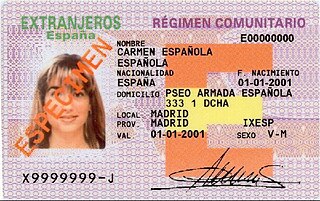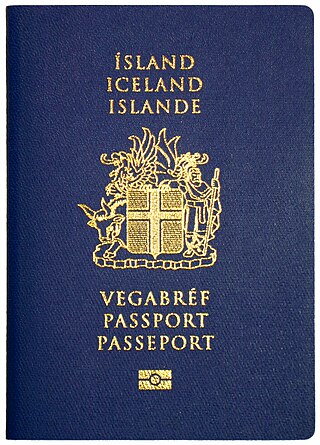
A visum is a conditional authorization granted by a polity to a foreigner that allows them to enter, remain within, or leave its territory. Visas typically include limits on the duration of the foreigner's stay, areas within the country they may enter, the dates they may enter, the number of permitted visits, or if the individual can work in the country in question. Visas are associated with the request for permission to enter a territory and thus are, in most countries, distinct from actual formal permission for an alien to enter and remain in the country. In each instance, a visa is subject to entry permission by an immigration official at the time of actual entry and can be revoked at any time. Visa evidence most commonly takes the form of a sticker endorsed in the applicant's passport or other travel document but may also exist electronically. Some countries no longer issue physical visa evidence, instead recording details only in immigration databases.
Permanent residency is a person's legal resident status in a country or territory of which such person is not a citizen but where they have the right to reside on a permanent basis. This is usually for a permanent period; a person with such legal status is known as a permanent resident. In the United States, such a person is referred to as a green card holder but more formally as a Lawful Permanent Resident (LPR).
The right of abode is an individual's freedom from immigration control in a particular country. A person who has the right of abode in a country does not need permission from the government to enter the country and can live and work there without restriction, and is immune from removal and deportation.

A travel document is an identity document issued by a government or international entity pursuant to international agreements to enable individuals to clear border control measures. Travel documents usually assure other governments that the bearer may return to the issuing country, and are often issued in booklet form to allow other governments to place visas as well as entry and exit stamps into them.

European Economic Area (EEA) citizens have the right of free movement and residence throughout the EEA. This right also extends to certain family members, even if they are not EEA citizens. A Residence card of a family member of a Union citizen is issued to the family member to confirm this right of residence. The holder of a valid Residence Card is entitled to use this document in lieu of an entry visa for entry to all EEA member states. There is not a unified format for this card throughout the EU.

The Citizens' Rights Directive 2004/38/EC sets out the conditions for the exercise of the right of free movement for citizens of the European Economic Area (EEA), which includes the member states of the European Union (EU) and the three European Free Trade Association (EFTA) members Iceland, Norway and Liechtenstein. Switzerland, which is a member of EFTA but not of the EEA, is not bound by the Directive but rather has a separate multilateral sectoral agreement on free movement with the EU and its member states.

An Italian passport is issued upon request to an Italian citizen for the purpose of international travel. It is valid for 10, 5 or 3 years, depending on the applicant's age. Its biometric version has been available since 2006.

The European Union itself does not issue ordinary passports, but ordinary passport booklets issued by its 27 member states share a common format. This common format features a colored cover emblazoned—in the official language(s) of the issuing country —with the title "European Union", followed by the name(s) of the member state, the heraldic "Arms" of the State concerned, the word "PASSPORT", together with the biometric passport symbol at the bottom center of the front cover.

The Italian electronic identity card, or simply carta d'identità, is an identification document issued to any Italian citizen and to legal aliens, that has been progressively replacing the paper-based identity card since version 3.0 was first released on 4 July 2016. The CIE is intended for both digital and physical identification. The biometric information is printed on an ID-1 card and stored in a contactless chip.

The visa policy of Canada requires that any foreign citizen wishing to enter Canada must obtain a temporary resident visa from one of the Canadian diplomatic missions unless they hold a passport issued by one of the 53 eligible visa-exempt countries and territories or proof of permanent residence in Canada or the United States.

Visa requirements for South African citizens are administrative entry restrictions by the authorities of other states placed on citizens of the Republic of South Africa.

The visa policy of the United Kingdom is the policy by which His Majesty's Government determines visa requirements for visitors to the United Kingdom, and the Crown dependencies of Guernsey, Jersey, and the Isle of Man and those seeking to work, study or reside there.

The visa policy of Ireland is set by the Government of Ireland and determines visa requirements for foreign citizens. If someone other than a European Union, European Economic Area, Common Travel Area or Swiss citizen seeks entry to Ireland, they must be a national of a visa-exempt country or have a valid Irish visa issued by one of the Irish diplomatic missions around the world.
Multiple citizenship is a person's legal status in which a person is at the same time recognized by more than one country under its nationality and citizenship law as a national or citizen of that country. There is no international convention that determines the nationality or citizenship status of a person, which is consequently determined exclusively under national laws, that often conflict with each other, thus allowing for multiple citizenship situations to arise.

National identity cards are issued to their citizens by the governments of most European Economic Area (EEA) member states, with the exception of Denmark and Ireland. In the European Union, identity cards have been harmonized as a new common identity card model replaced the various formats in use on 2 August 2021.
A long-term resident in the European Union is a person who is not a citizen of an EU country but has resided legally and continuously within its territory for five years with a means of support and fulfills some further requirements, as defined in Directive 2003/109/EC. The status permits the holder some of the rights of free movement afforded to EU/EEA citizens in the participating countries; of the EU countries Denmark and Ireland do not participate in implementing the Directive. The implementation of the directive is left to the participating countries, with some national variations in the requirements for and benefits of long-term resident status.

Passports of the EFTA member states are passports issued by the European Free Trade Association (EFTA) member states Iceland, Liechtenstein, Norway and Switzerland. EFTA is in this article used as a common name for these countries.

Automated border control systems (ABC) or eGates are automated self-service barriers which use data stored in a chip in biometric passports along with a photo or fingerprint taken at the time of entering the eGates to verify the passport holder's identity. Travellers undergo biometric verification using facial or iris recognition, fingerprints, or a combination of modalities. After the identification process is complete and the passport holder's identity is verified, a physical barrier such as a gate or turnstile opens to permit passage. If the passport holder's identification is not verified or if the system malfunctions, then the gate or turnstile does not open and an immigration officer will meet the person. E-gates came about in the early 2000s as an automated method of reading the then-newly ICAO mandated e-passports.
In Italy the temporary residence permit is controlled by the Polizia di Stato, who are under the tutelage of the Ministry of the Interior. It must be requested by the immigrant to be allowed to reside in the country for more than eight days, or more than ninety days if having a travel visa for tourism. It is not required for European Union citizens. Permessi are governed by the legislative decree 25 July 1998 n. 286 and the related implementation regulation pursuant to Presidential Decree no. 179 of 14 September 2011.
The European Union Settlement Scheme is an immigration regime of the United Kingdom introduced by the Home Office in 2019, under the new Appendix EU of the UK's Immigration Rules, in response to the Brexit situation. EUSS processes the registration of nationals of EU and EFTA countries who were resident in the United Kingdom prior to the end of the Brexit transition/implementation period at 11pm GMT on 31 December 2020. Successful applicants receive either 'pre-settled status' or 'settled status', generally depending on the length of time they have been resident in the United Kingdom.












